Raydium, as the main liquidity provider and automated market maker (AMM) on the Solana network, has a strategic advantage in capturing emerging market trends due to its unique position.
Author: Kyle Cai
Compiled by: Deep Tide TechFlow
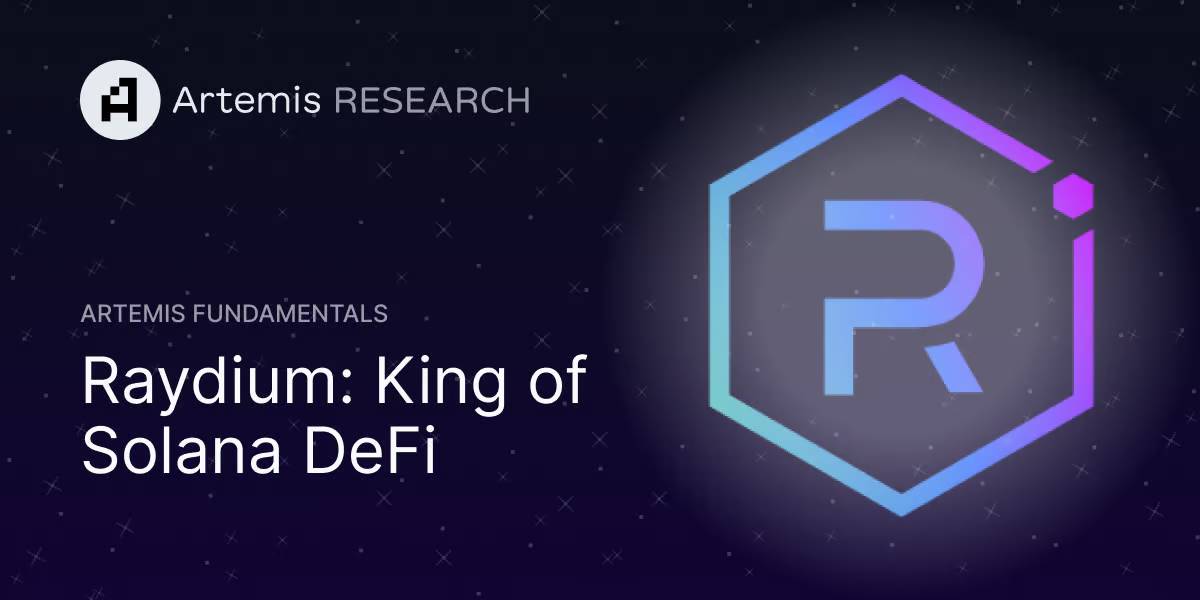
Disclaimer: The Artemis team does not endorse any specific financial, investment, or legal strategies. This article is for informational and educational purposes only and should not be considered financial, investment, or legal advice. All investments carry risks, and past performance does not guarantee future results. Please conduct your own research and consult a licensed financial advisor before making any investment decisions.
Overview
In the 2024 cycle, Solana has performed exceptionally well, with the main theme of this cycle being Memecoins, all of which were born on Solana. Solana is also the first-layer blockchain with the largest price increase this year, rising by approximately 680%. While Memecoins are closely linked to Solana, the ecosystem has regained widespread attention since the recovery in 2023, thriving with protocols like Drift (decentralized perpetual contract exchange), Jito (liquid staking), and Jupiter (decentralized exchange aggregator), whose token valuations have reached billions of dollars. Solana's active addresses and daily trading volume surpass all other blockchains.
At the center of this thriving ecosystem is Raydium, Solana's top decentralized exchange. The saying "sell shovels during a gold rush" perfectly embodies Raydium's role: while Memecoins attract public attention, Raydium supports these activities by providing liquidity and trading. With the continuous flow of Memecoin trading and broader DeFi activities, Raydium has firmly established itself as one of the critical infrastructures in the Solana ecosystem.
At Artemis, we believe the world is increasingly relying on fundamentals. Therefore, this article aims to analyze Raydium's unique position in the Solana ecosystem from first principles using a data-driven approach. Let's dive in:
Introduction to Raydium
Launched in 2021, Raydium is an automated market maker (AMM) based on the Solana blockchain, offering permissionless liquidity pool creation, lightning-fast trading, and yield generation methods. Raydium's uniqueness lies in its architectural design—it is the first AMM on Solana and pioneered a hybrid AMM compatible with order books in decentralized finance (DeFi).
When Raydium launched, it adopted a hybrid AMM model that allowed idle pool liquidity to be shared with a centralized limit order book, whereas other decentralized exchanges (DEXs) at the time could only use liquidity within their own pools. This means that the liquidity on Raydium simultaneously created a market on OpenBook, which could be traded through any OpenBook DEX graphical user interface.
While this feature was a major differentiator in the early days, it has since been disabled due to the influx of numerous long-tail markets. Raydium currently offers three different types of liquidity pools, including:
Standard AMM Pool (AMM v4), which is the original hybrid AMM
Constant Product Market Maker (CPMM), supporting Token 2022
Concentrated Liquidity Market Maker (CLMM)
On Raydium, a small fee is charged for each swap based on the specific pool type and fee tier. These fees are allocated to incentivize liquidity providers, repurchase RAY tokens, and support the treasury.
We have recorded the trading fees, pool creation fees, and protocol fees for different types of pools on Raydium. Here is a brief explanation of these terms and their corresponding fee levels:
Trading Fee: This is the fee charged to traders when making a swap.
Repurchase Fee: This is a portion extracted from the trading fee used to repurchase Raydium tokens.
Treasury Fee: This is a portion of the trading fee allocated to the treasury.
Pool Creation Fee: This is the fee charged when creating a pool, aimed at preventing abuse of pool creation. The pool creation fee is controlled by the protocol's multi-signature and is used to cover the infrastructure costs of the protocol.
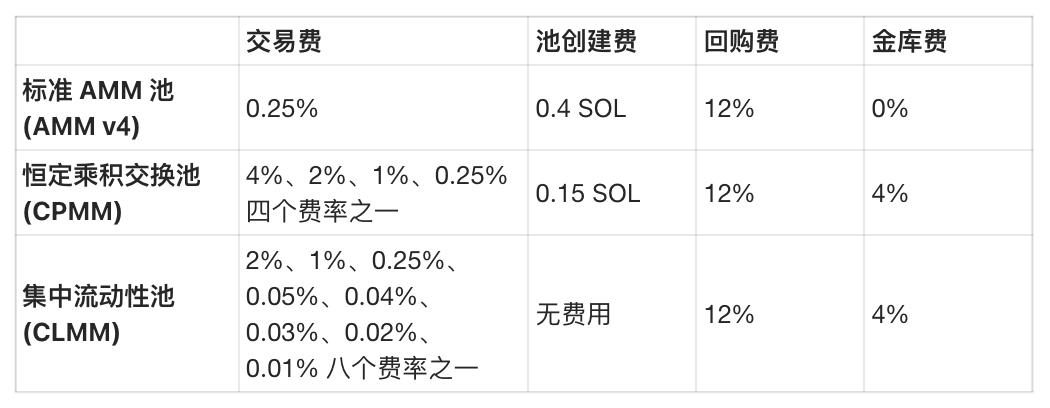
Figure 1. Raydium Fee Structure
Solana's Decentralized Exchange (DEX) Ecosystem
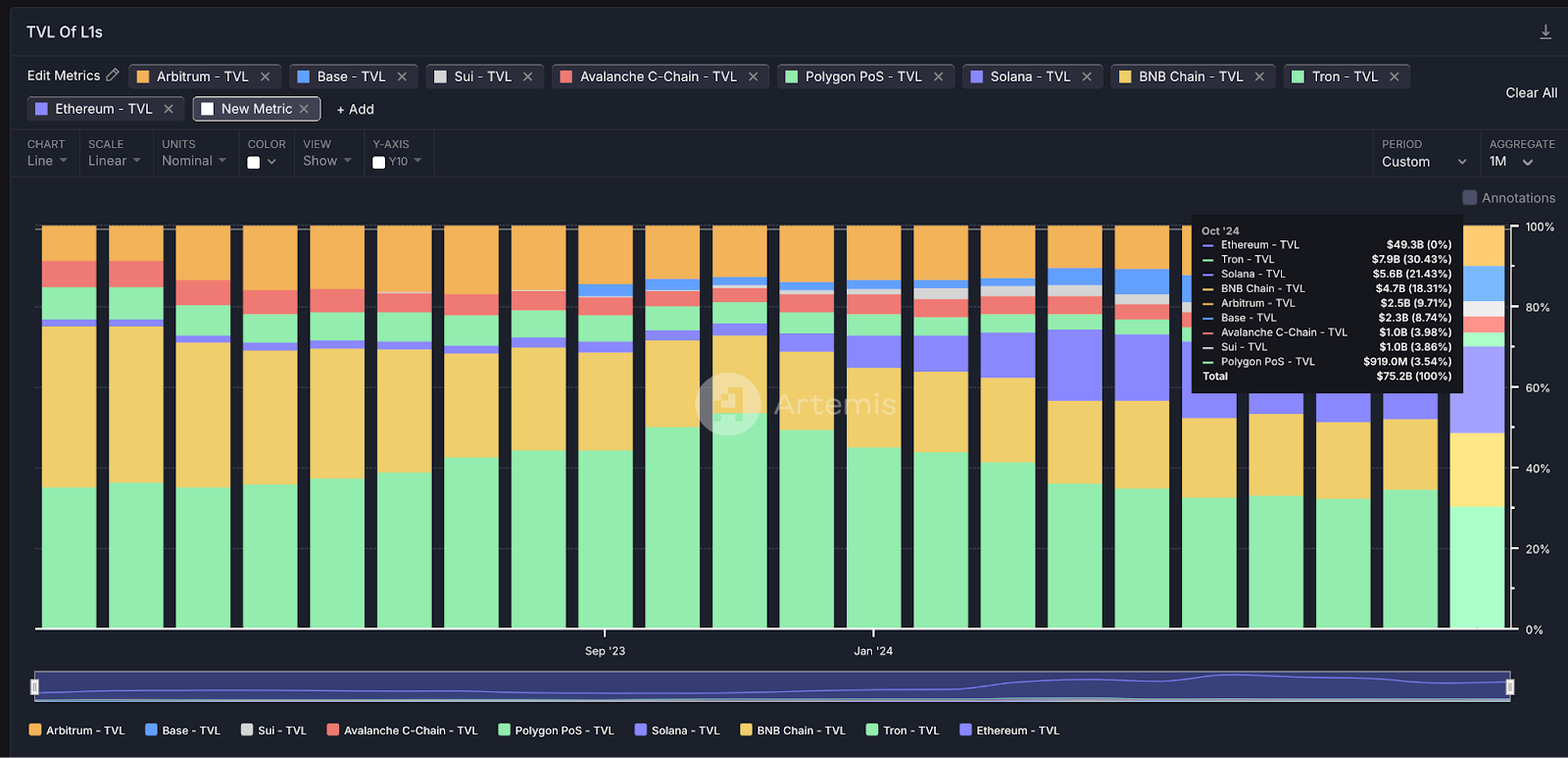
Figure 2. Total Value Locked (TVL) of Various DEXs on Solana
Source: Artemis
After detailing Raydium's operational mechanisms, we will continue to assess Raydium's position within the Solana DEX ecosystem. It is evident that Solana has rapidly risen in the 2024 market cycle, becoming the third-largest chain by total value locked, following Ethereum and Tron.
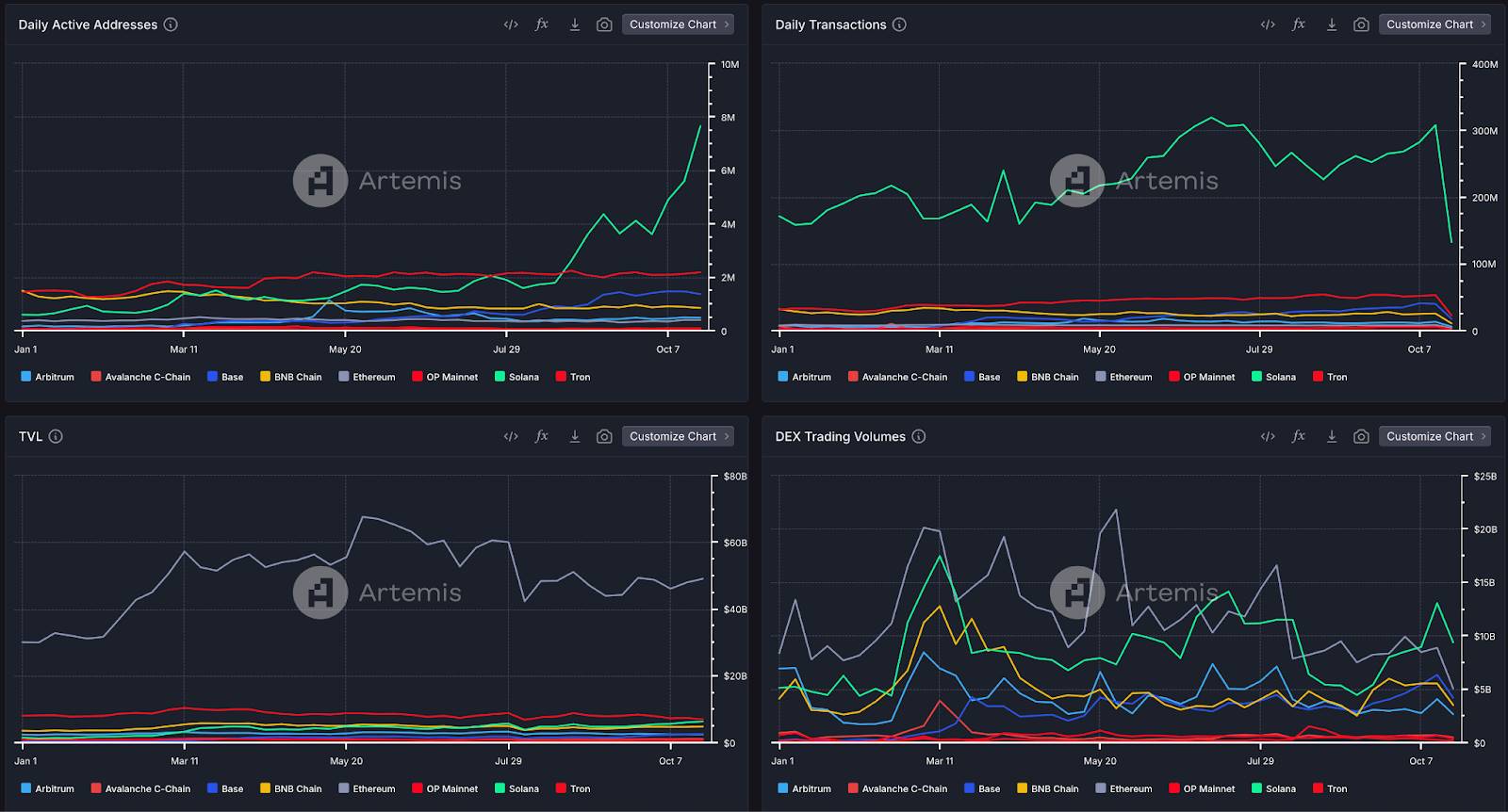
Figure 3. Daily Active Addresses, Daily Trading Volume, TVL, and DEX Trading Volume of Various Chains
Source: Artemis
In terms of user activity metrics, Solana has consistently led, including daily active addresses, daily trading volume, and DEX trading volume. This increase in activity and liquidity can be attributed to several factors, one of the most notable being the "Meme Coin Craze" on Solana. The high transaction speed and low costs of Solana, combined with its good user experience for decentralized applications, have facilitated rapid growth in on-chain trading. With tokens like $BONK and $WIF reaching billion-dollar market capitalizations, along with the emergence of Meme coin launch platforms like Pump.fun, Solana has become an important hub for Meme coin trading.
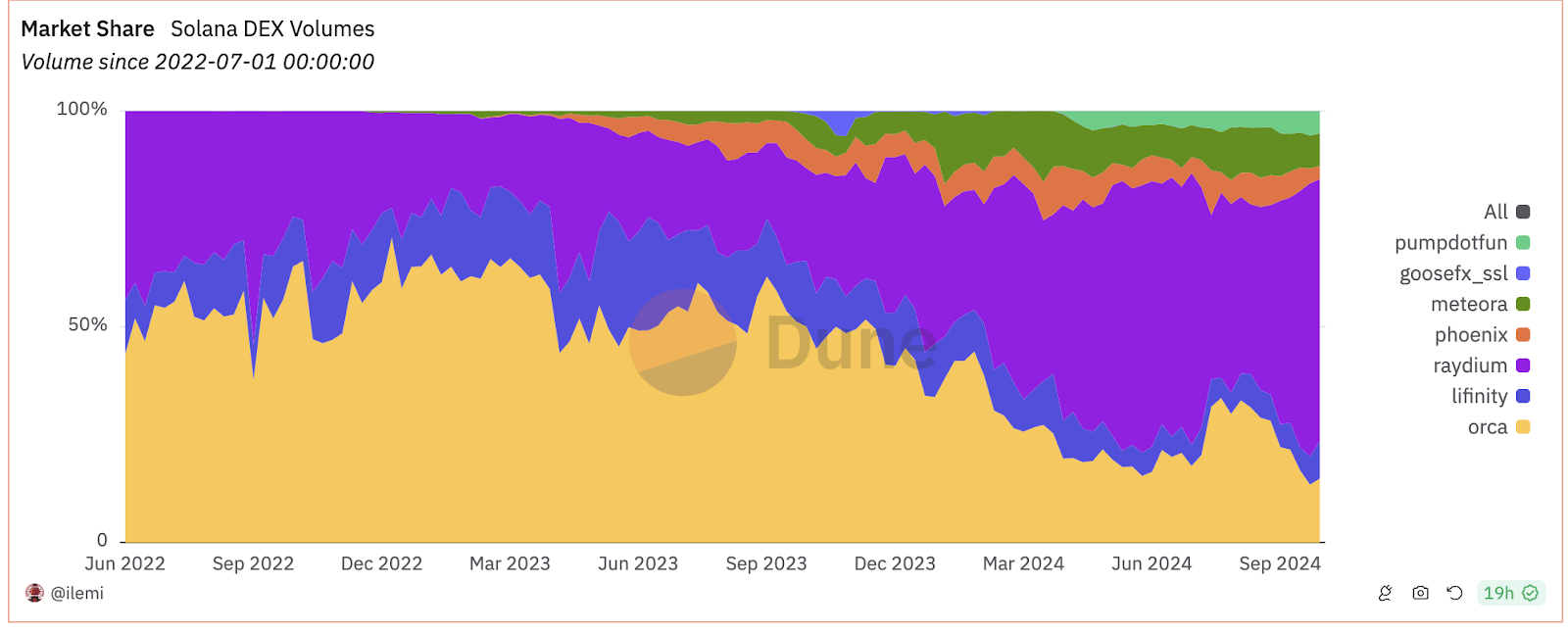
Figure 4. Market Share of Trading Volume Among Various Decentralized Exchanges (DEXs) on the Solana Network
Source: Ilemi’s Raydium Dune Dashboard
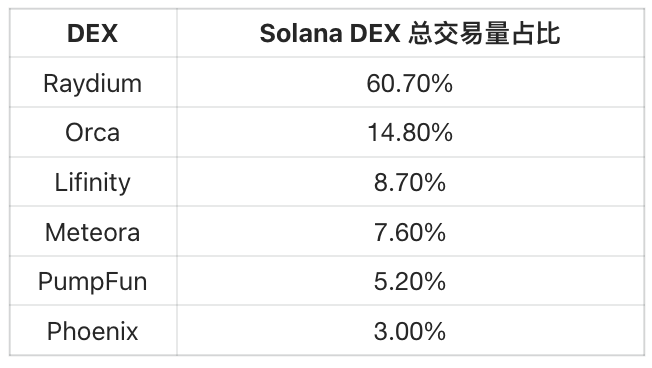
In this cycle, Solana has become the most popular first-layer blockchain (Layer 1) and continues to lead in trading activity compared to other L1s. As trading activity increases, decentralized exchanges (DEXs) on Solana benefit significantly—more traders bring more trading fees, creating more revenue for the protocols. However, among numerous DEXs, Raydium stands out, successfully capturing a significant market share. As shown in the figure below:
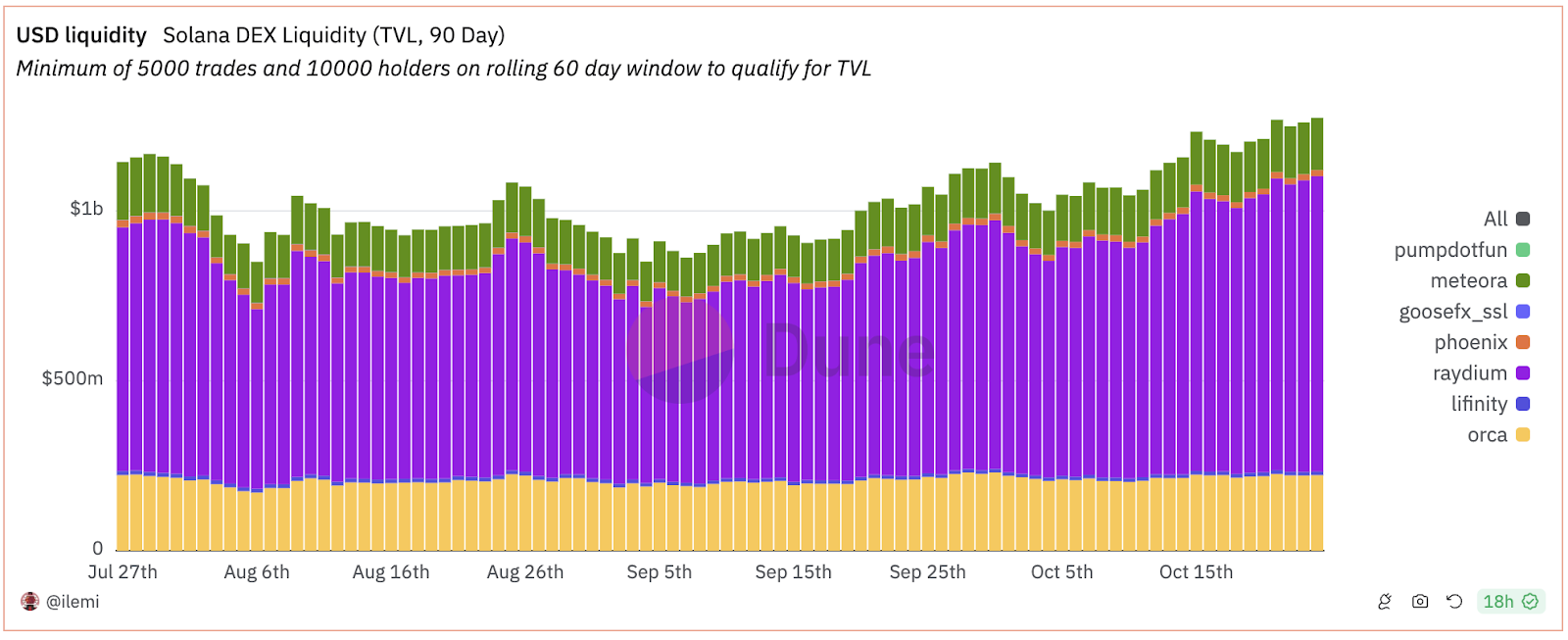
Figure 4. Market Share of Solana DEX Trading Volume Among Various DEXs
Source: Ilemi’s Raydium Dune Dashboard
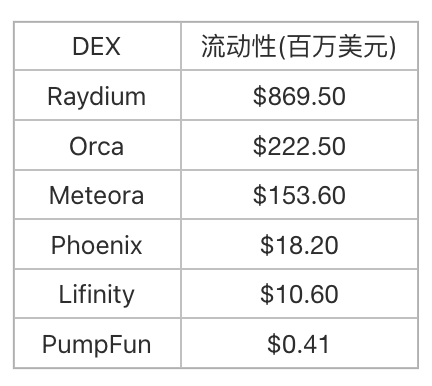
Raydium continues to maintain its position as the most liquid decentralized exchange (DEX). It is worth noting that the operation of DEXs often involves issues of economies of scale, as traders typically prefer the exchanges with the highest liquidity to avoid slippage during trades. The higher the liquidity, the more traders are attracted, which in turn further attracts liquidity providers who profit by charging trading fees, creating a virtuous cycle that draws in more traders looking to avoid slippage.
When comparing different DEXs, liquidity is often an overlooked but crucial factor, especially evident when trading Memecoins on the Solana network. Memecoins typically suffer from low liquidity and require a centralized trading point. If liquidity is dispersed across different DEXs, it can lead to a poor user experience and inconvenience when purchasing Memecoins on various DEXs.
Exploring the Relationship Between Memecoins and Raydium
Raydium's popularity is also linked to the resurgence of Memecoins on Solana, particularly the Memecoin platform launched by PumpFun. Since its establishment earlier this year, PumpFun has generated over $100 million in fees through its platform.
The Memecoins on the PumpFun platform have a close collaboration with Raydium. When the market capitalization of a token launched on Pump.fun reaches $69,000, Pump.fun automatically injects $12,000 worth of liquidity into Raydium. This mechanism makes Raydium the platform with the strongest liquidity for trading Memecoins. This process creates a virtuous cycle: PumpFun connects to Raydium > Memecoins are launched on Raydium > People trade here > Liquidity increases > More Memecoins are launched here > More liquidity is obtained, and so on.

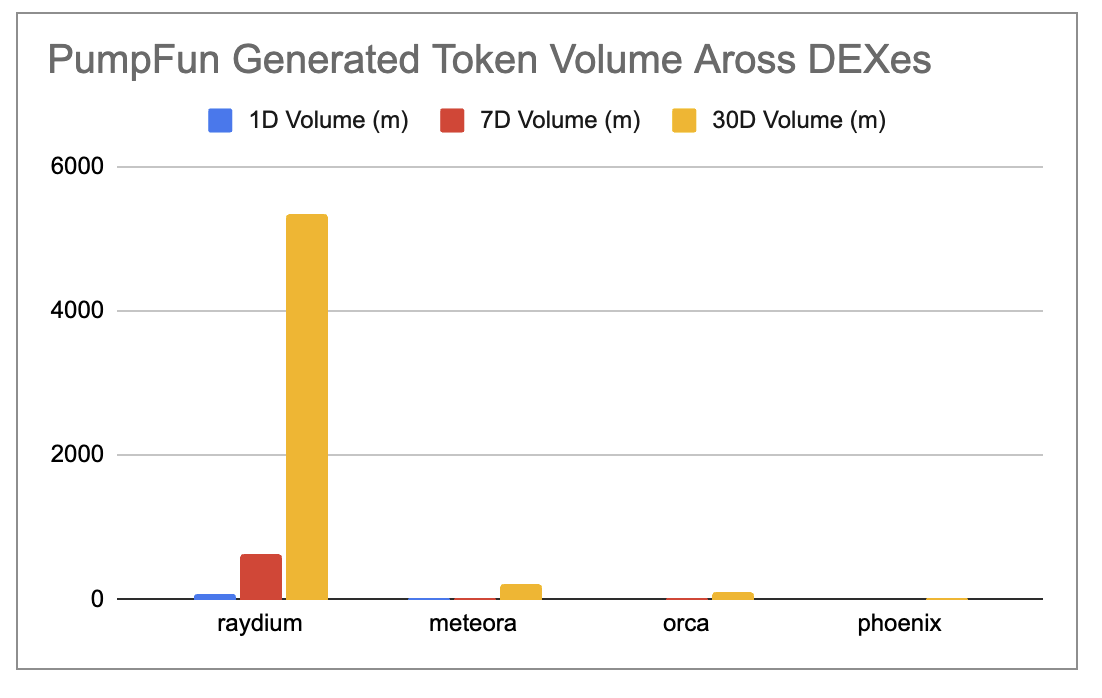
Figure 6. Trading Volume of Tokens Generated by PumpFun Across DEXs
Source: Hashed_em's Memecoin Volume Dune Dashboard
As a result, Raydium is considered to follow a power law, with over 90% of the Memecoins generated by PumpFun being traded on Raydium. Like a large shopping mall in a city, Raydium is the largest "shopping center" on Solana, meaning that most users choose to "shop" at Raydium, while most "merchants" (tokens) also wish to set up "stores" there.
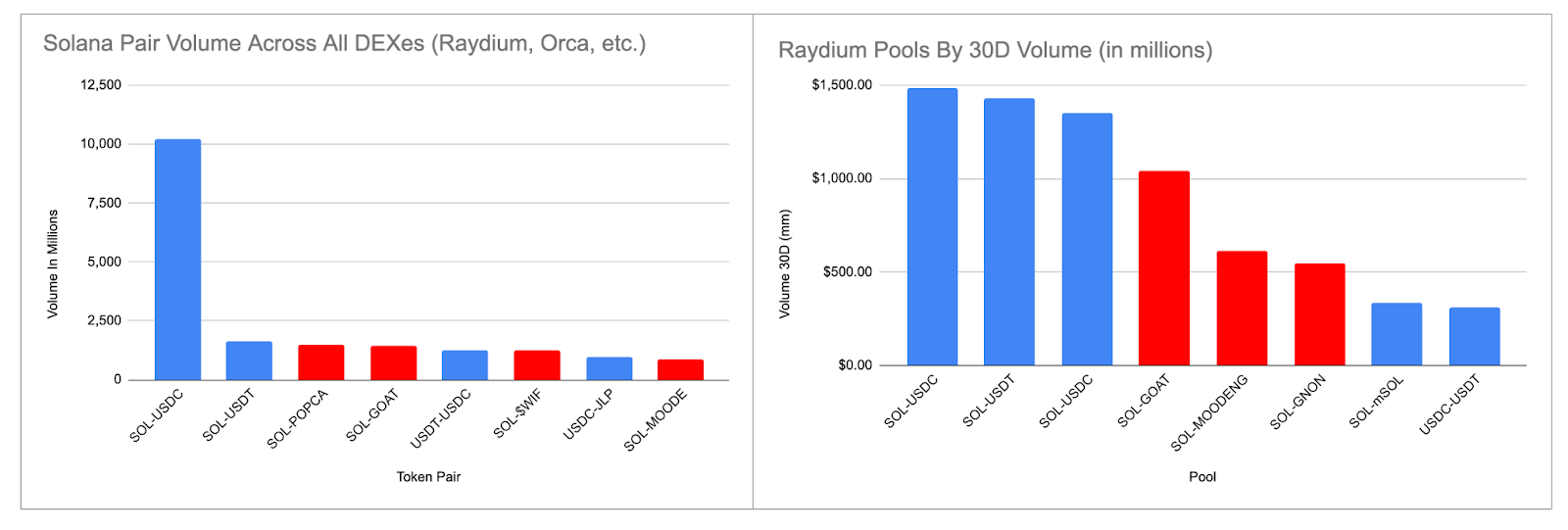
Figure 7. Comparison of 30-Day Trading Volume of Trading Pairs on Various DEXs with Trading Pairs on Raydium
(Red represents Memecoins, blue represents non-Memecoins)
Source: Ilemi's Raydium Dune Dashboard, Raydium
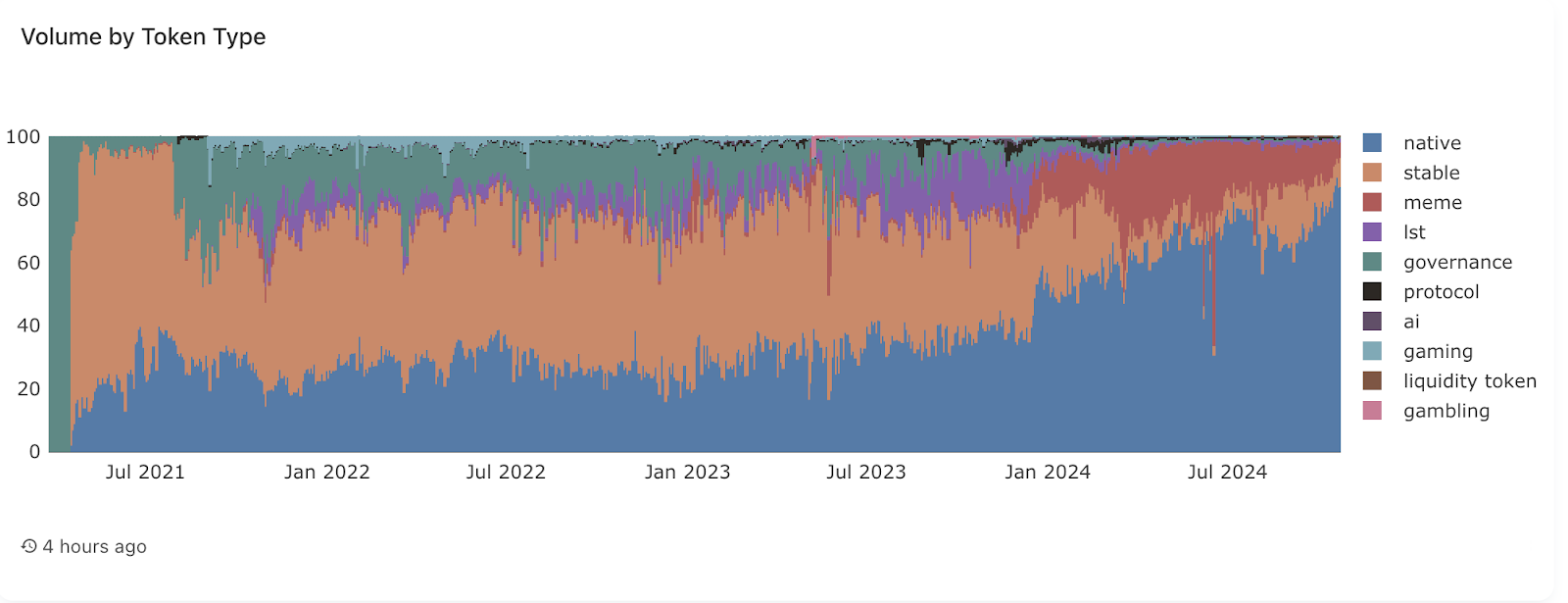
Figure 8. Trading Volume on Raydium by Token Type
Source: Complete Raydium Dashboard
However, it should be noted that while PumpFun relies on Raydium, Raydium does not entirely depend on Memecoins to maintain its trading volume. In fact, according to Figure 8, the three trading pairs with the highest trading volume in the past 30 days are SOL-USDT and SOL-USDC, which together account for over 50% of the total trading volume. (It is important to note that the two SOL-USDC trading pairs here are two independent pools with different fee structures).
Figures 7 and 9 further validate this point. Figure 7 shows that the SOL-USDC trading pair far outpaces other DEX trading pairs in terms of trading volume. Even though Figure 7 displays the trading volume of all DEXs, it indicates that the trading volume of the entire ecosystem is not solely driven by Memecoins. Figure 9 further illustrates Raydium's trading volume by token type, where "native" tokens account for over 70% of the market share. Therefore, while Memecoins are an important component of Raydium, they do not represent all of Raydium's trading activity.

Figure 9. PumpFun Revenue
Source: Defillama
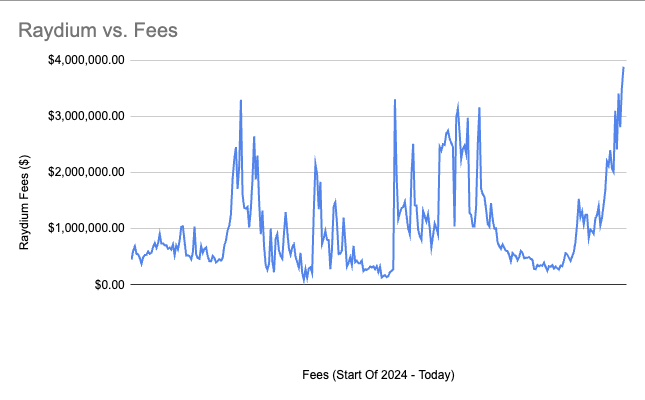
Figure 10. Raydium Revenue
Source: Artemis Excel Plugin
Nevertheless, Memecoins are highly volatile, and liquidity pools with high volatility typically charge higher fees. Therefore, although Memecoins may not match the trading volume of Solana's liquidity pools, they contribute significantly to Raydium's revenue and fees. This is reflected in the data from September—since Memecoins are highly cyclical assets, their performance often declines sharply during poor market conditions as risk appetite decreases. PumpFun's revenue dropped by 67% from an average of $800,000 per day in July and August to about $350,000 per day in September; we also observed a decline in Raydium's fees during the same period.
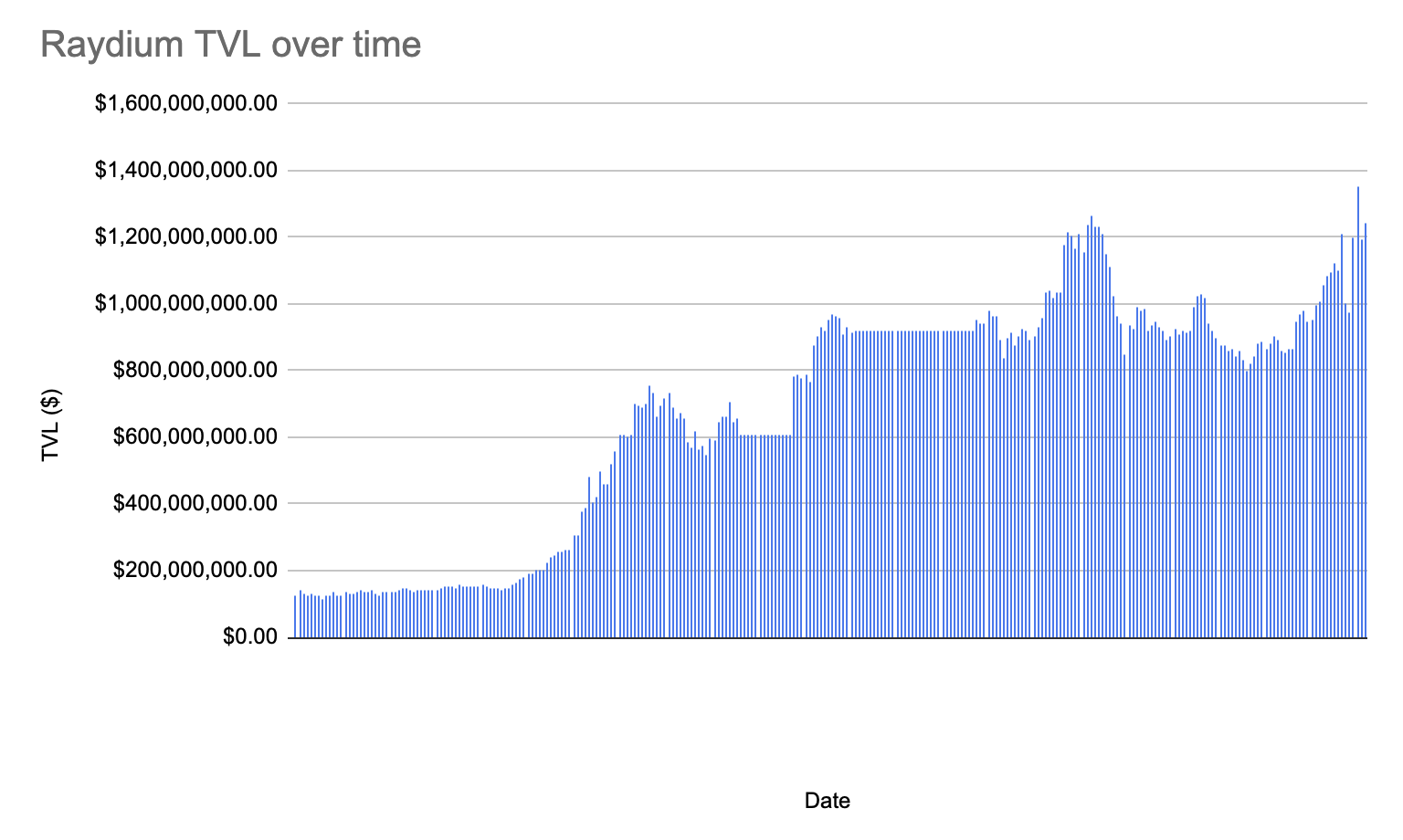
Figure 11. Raydium's TVL Over Time
Source: Artemis Excel Plugin
However, like other areas of the cryptocurrency industry, this sector is highly cyclical, so it is normal for indicators to decline during bear markets as risk is washed out. Conversely, we can view TVL as a measure of the protocol's true antifragility—while revenue is highly cyclical and fluctuates with the arrival and departure of speculators, TVL is a metric that can reflect the sustainability of a DEX, showing how it withstands the test of time. TVL is akin to the "occupancy rate" of a shopping mall—although trends may change and mall usage may vary with the seasons, as long as the occupancy rate is above average, we can judge its success.
Like a shopping center with stable foot traffic, Raydium's TVL has remained stable over the long term. This indicates that while its revenue may fluctuate with changes in market prices and investor sentiment, Raydium has proven its position as a core product within the Solana ecosystem and has become the most outstanding and liquid DEX on Solana. Therefore, although Memecoins contribute to its revenue, Raydium's trading volume does not always rely on Memecoins; liquidity continues to concentrate on Raydium regardless of market conditions.
Comparison of Raydium with Aggregators
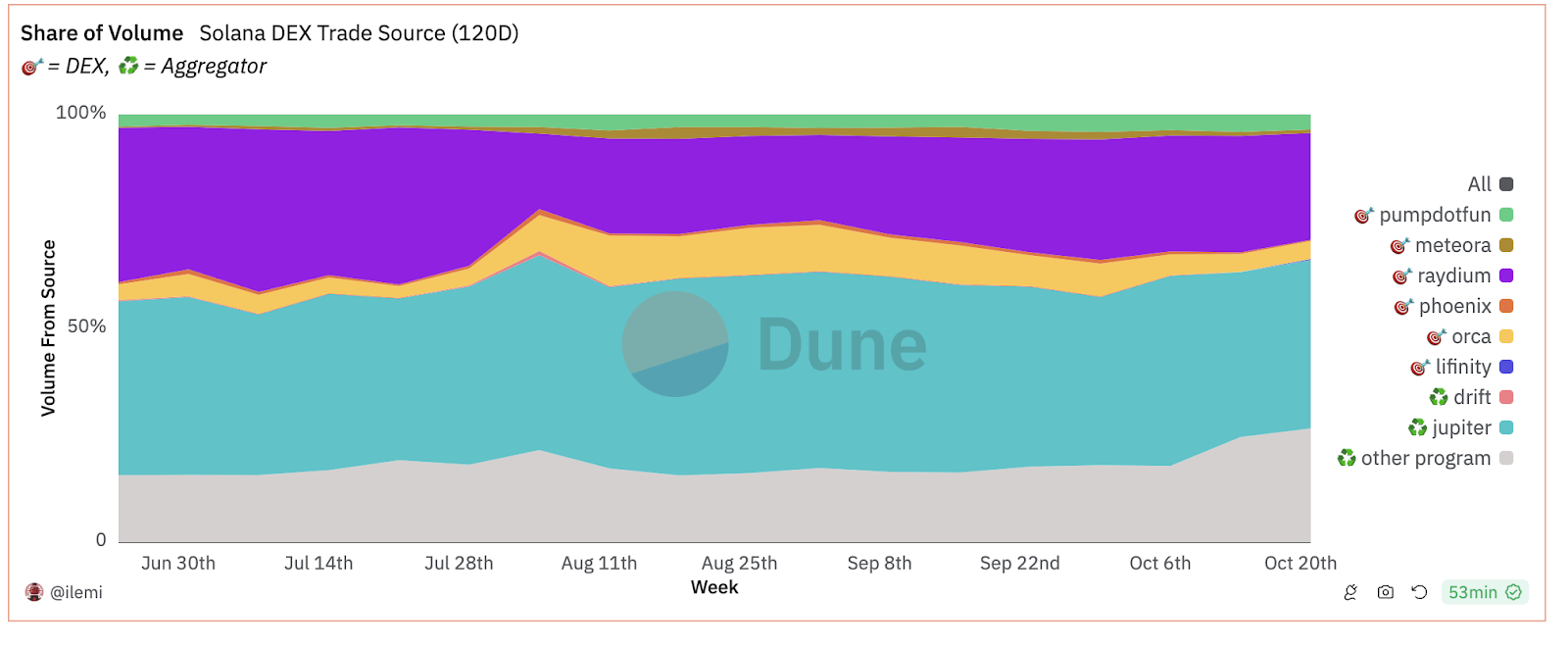
Figure 12. Sources of Trading on Solana DEX
Source: Ilemi's Raydium Dune Dashboard
While Jupiter and Raydium do not directly compete, Jupiter plays a key aggregator role in the Solana ecosystem by routing trades through multiple decentralized exchanges (DEXs), including Raydium. Jupiter essentially acts as a meta-platform, ensuring users get the best prices by sourcing liquidity from various DEXs like Orca, Phoenix, and Raydium. In contrast, Raydium serves as a liquidity provider, supporting many trades routed by Jupiter by providing deep liquidity pools for Solana tokens.

Figure 13. 24-Hour Trading Volume of Jupiter by AMM
Source: Ilemi's Jupiter by AMM Dune Dashboard
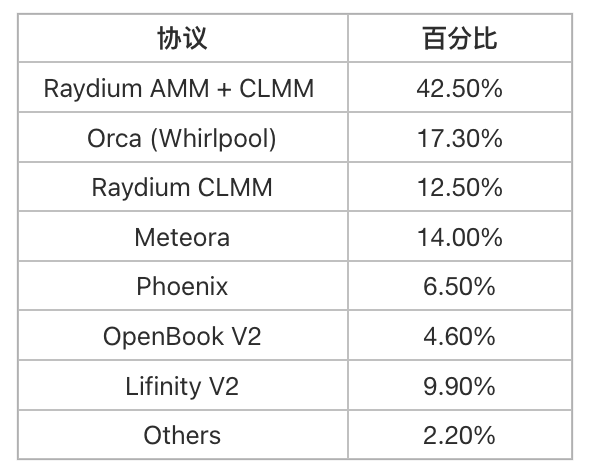
Despite the close collaboration between Raydium and Jupiter, it is noteworthy that the proportion of trading volume directly generated by Raydium is gradually increasing, while the proportion from Jupiter is declining. At the same time, Raydium accounts for nearly half of the trading volume generated by Jupiter.
This indicates that Raydium has successfully built a more robust and self-sufficient platform that can directly attract users without relying on third-party aggregators like Jupiter.
The increase in direct trading volume means that traders find value in using Raydium's native interface and liquidity pools, as users seek the most efficient and comprehensive DeFi experience without going through an aggregator. Ultimately, this trend emphasizes Raydium's independent status as a primary liquidity provider in the Solana ecosystem.
Comparison of Raydium with Other Platforms
Finally, we created a comparison chart using the Artemis plugin to showcase Raydium's comparison with other DEXs on Solana, including aggregators.
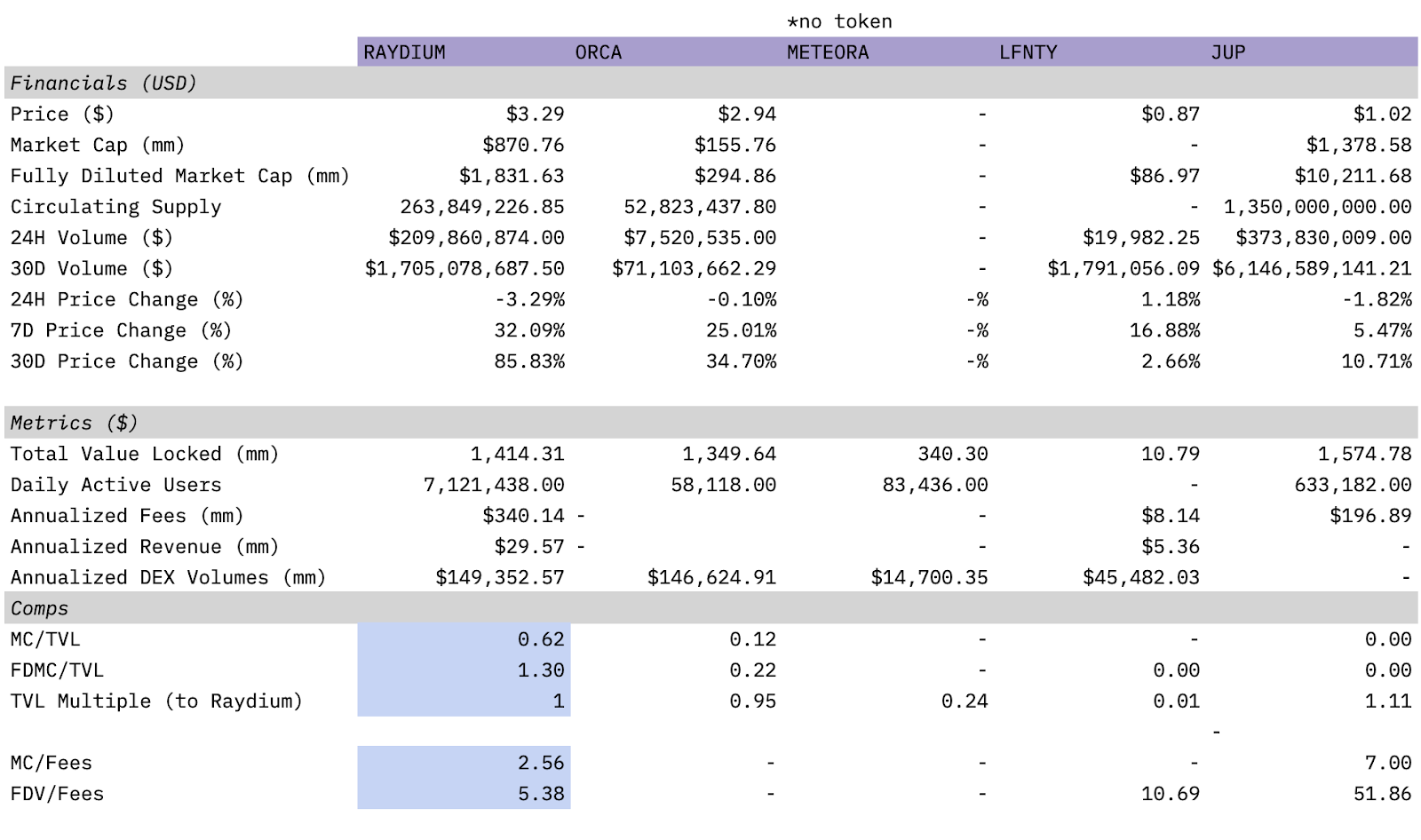
Figure 14. Comparison of Raydium with Other DEXs on Solana
Source: Artemis Excel Plugin
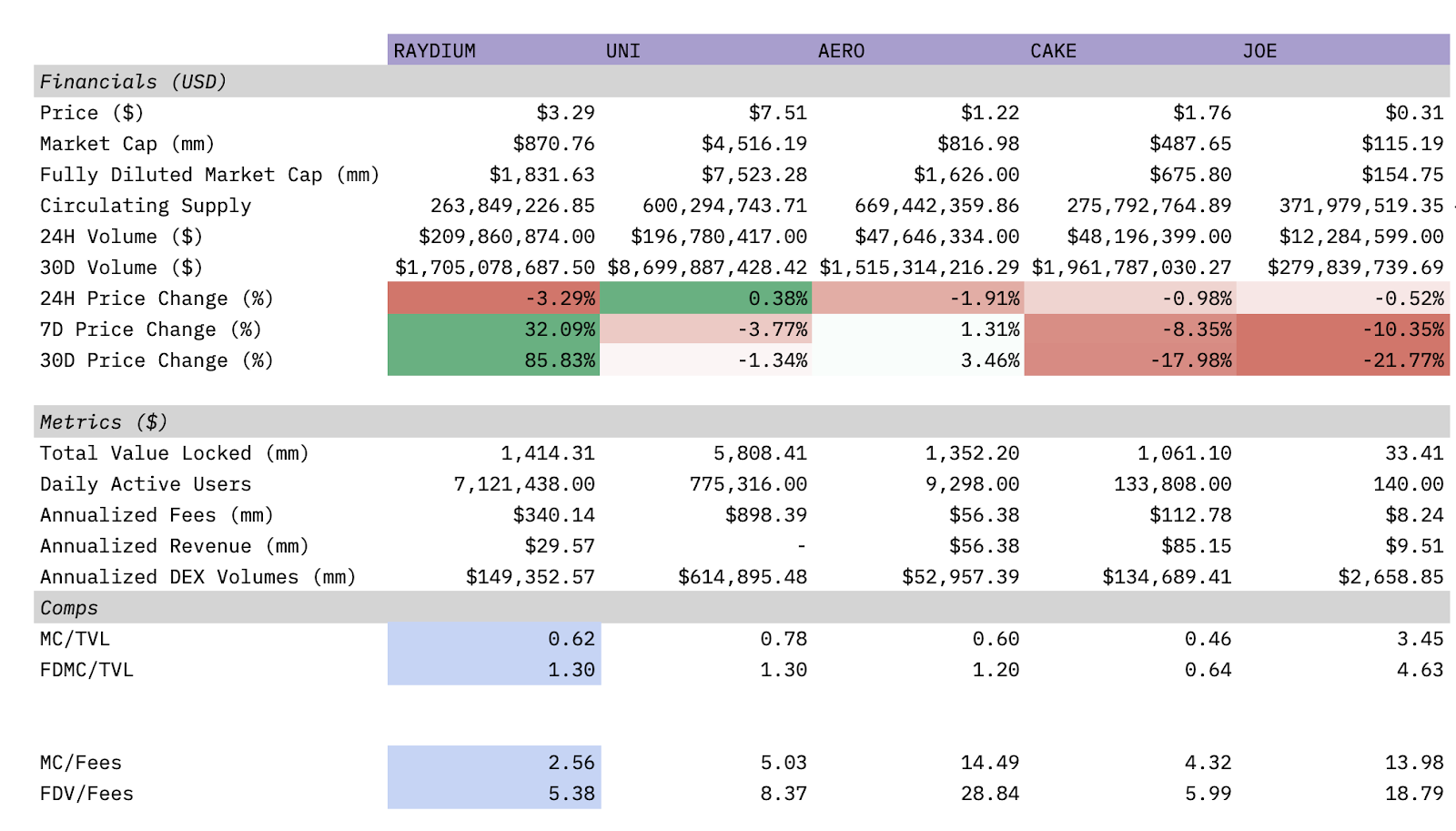
Figure 15. Comparison of Raydium with Other Popular DEXs
Source: Artemis Excel Plugin
In Figure 13, we compared Raydium with the most popular DEXs on Solana, including Orca, Meteora, and Lifinity, which together account for 90% of the total DEX trading volume on Solana. We also included Jupiter as an aggregator in the comparison. Although Meteora has not issued a token, we still included it in the comparison.
The data shows that Raydium has the lowest market cap/fee ratio and FDV/fee ratio among all DEXs. Raydium also has the highest number of daily active users, with other DEXs having over 80% less TVL than Raydium, excluding Jupiter (which is considered an aggregator rather than a DEX).
In Figure 14, we compared Raydium with traditional DEXs on other chains. It can be seen that Raydium's annualized DEX trading volume is more than twice that of Aerodrome, yet its market cap/earnings ratio is lower.
Raydium's Token Economics
Here are the details of Raydium's token economics:
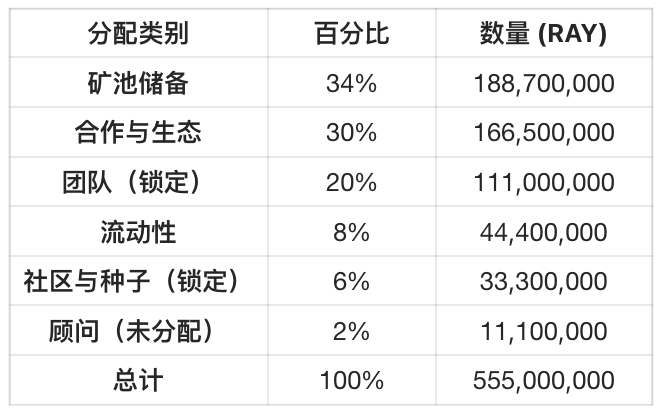
Note: The tokens for the team and seed round (accounting for 25.9% of the total) are fully locked for the first 12 months after the token generation event (TGE) and will be unlocked linearly on a daily basis from the 13th to the 36th month. The lock-up period ends on February 21, 2024.
Raydium tokens have multiple uses: users holding $RAY can earn additional tokens through staking. Additionally, $RAY is used as mining rewards to attract liquidity providers, thereby enhancing the depth of liquidity pools. Although $RAY itself is not a governance token, a related governance mechanism is under development.
Despite a decrease in market interest in token issuance after the DeFi summer, it is worth mentioning that Raydium has a very low annual inflation rate, and its annualized buyback performs excellently in the DeFi space. Currently, the annual issuance is about 1.9 million RAY, of which 1.65 million is used for staking, which is relatively small compared to the issuance of other popular decentralized exchanges at their peak. At current market prices, RAY issues approximately $5.1 million worth of tokens annually. In contrast, Uniswap issues tokens worth about $1.45 million daily before full unlock, with an annual issuance of $529.25 million.
A small fee is charged for each transaction on Raydium. According to the official documentation, "this fee is allocated based on the specific pool's fees, used to incentivize liquidity providers, buy back RAY, and replenish the treasury. Overall, regardless of the pool's fee tier, 12% of all trading fees are used to buy back RAY." Combined with Raydium's trading volume, this mechanism has a significant effect.
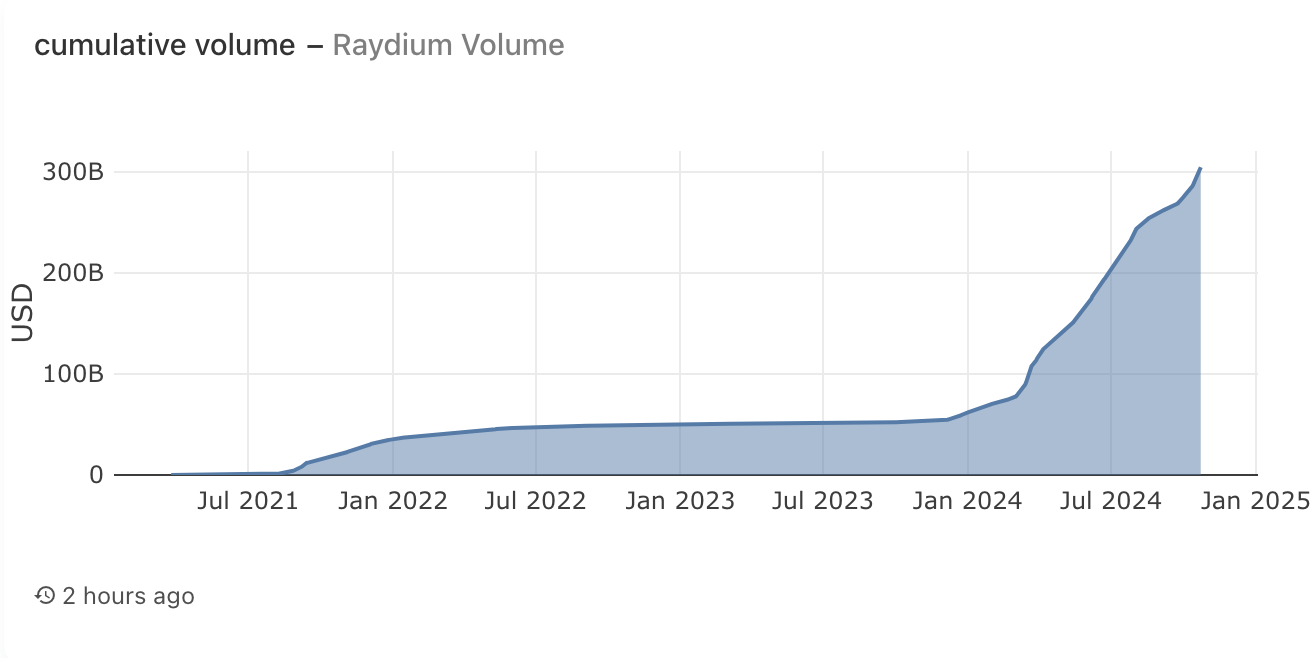
Figure 16. Cumulative Trading Volume of Raydium
Source: Full Raydium Dashboard

Figure 17. Raydium Buyback Data
Source: Full Raydium Dashboard
From the data results, Raydium's performance is outstanding. The cumulative trading volume has exceeded $300 billion, and Raydium has successfully repurchased approximately 38 million RAY tokens, valued at around $52 million. Raydium's buyback program is the strongest in the entire decentralized finance (DeFi) sector, which has also positioned Raydium as a leader among all decentralized exchanges (DEXs) on the Solana network.
Raydium's Development Prospects
In summary, Raydium has significant advantages among decentralized exchanges on the Solana network, and in the context of Solana's continuous development, Raydium is in the most favorable position. The development journey of Raydium over the past year has been impressive, and as Memecoins continue to dominate the cryptocurrency market, Raydium's growth momentum does not seem to be slowing down anytime soon. The recent Memecoin craze revolves around artificial intelligence (AI), such as $GOAT.
As a major liquidity provider and automated market maker (AMM) on the Solana network, Raydium has a strategic advantage in capturing emerging market trends due to its unique position. Additionally, Raydium's commitment to innovation and ecosystem development is reflected in its frequent system upgrades, strong incentives for liquidity providers, and active engagement with the community. These factors indicate that Raydium is not only well-prepared to adapt to the ever-changing decentralized finance (DeFi) environment but also has the potential to lead the field.
As a key infrastructure in the rapidly growing blockchain ecosystem, if Raydium continues to maintain its current development momentum, its future growth prospects can be considered very optimistic.
免责声明:本文章仅代表作者个人观点,不代表本平台的立场和观点。本文章仅供信息分享,不构成对任何人的任何投资建议。用户与作者之间的任何争议,与本平台无关。如网页中刊载的文章或图片涉及侵权,请提供相关的权利证明和身份证明发送邮件到support@aicoin.com,本平台相关工作人员将会进行核查。




